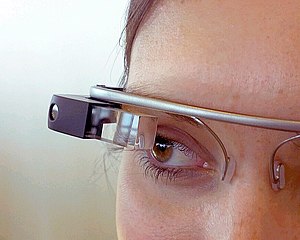A new perspective to the future.
Google picking up the future steps with the help of augmented reality. and named as "PROJECT GLASS".
 A photo of a Google Glass prototype seen atGoogle I/O in June of 2012 | |
| Developer | |
|---|---|
| Type | Augmented reality, head-mounted display |
| Release date | Developers (US): early 2013 Consumers: late 2013-early 2014[1] |
| Introductory price | Developer version: $1,500 USD[1] |
Project Glass is a research and development program by Google to develop anaugmented reality head-mounted display (HMD). Project Glass products would display information in smartphone-like format hands-free and could interact with the Internet vianatural language voice commands. The prototype's functionality and minimalist appearance (aluminium strip with 2 nose pads) has been compared to Steve Mann's EyeTap.
The operating system software used in the glasses will be Google's Android.
Project Glass is being developed by Google X Lab,which has worked on other futuristic technologies such as self-driving cars. The project was announced on Google+ by Babak Parviz, an electrical engineer who has also worked on putting displays into contact lenses; Steve Lee, a project manager and "geolocation specialist"; and Sebastian Thrun, who developed Udacity as well as worked on the self-driving car project.[8] Google has patented the design of Project Glass.[9]
video showing "ONE DAY with Google glass"
What is Augmented reality (AR) ?
It is a live, direct or indirect, view of a physical, real-world environment whose elements are augmented by computer-generated sensory input such as sound, video, graphics or GPS data. It is related to a more general concept called mediated reality, in which a view of reality is modified (possibly even diminished rather than augmented) by a computer. As a result, the technology functions by enhancing one’s current perception of reality. By contrast, virtual reality replaces the real world with a simulated one. Augmentation is conventionally in real-time and in semantic context with environmental elements, such as sports scores on TV during a match. With the help of advanced AR technology (e.g. adding computer vision and object recognition) the information about the surrounding real world of the user becomes interactive and digitally manipulable. Artificial information about the environment and its objects can be overlaid on the real world.
with love kiran lal P.R
mesothelioma lawsuits
 Cessna Product Link
Cessna Product Link
No comments:
Post a Comment